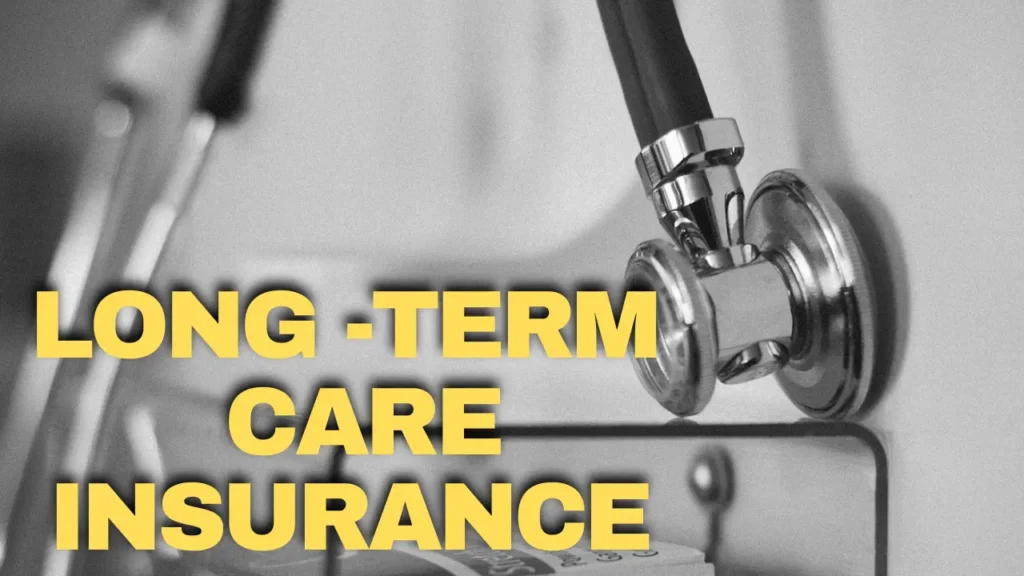Plotting for LTCI is a noteworthy piece of fiscal organizing — and the older you get, the odds are more prominent that at some point or another, you will surely need medicinal services to help give day-by-day mind. With health care costs skyrocketing, not to mention a longer life expectancy (currently 78 years), long-term care insurance is another way you can protect yourself from depleting your savings and becoming dependent on children or others. Below is a summary of long-term care insurance as well: what it is; how much LTC coverage costs; and who may need this expertise in your financial planning.
What is Long-Term Care?
Long-term care insurance: This covers nursing home costs and assistance for people who cannot perform the basic tasks of daily living (like the chronically ill and disabled). Mobility is an essential component of basic human activity and life as it involves moving oneself from one location to another, agility enabling a person to also be outdoors, and the ability for positive reinforcement in travel like work or other means.; continence training, and toileting. LTCI covers care in the following settings:
Nursing Homes – provide full-time, 24-hour nursing care for individuals with conditions that require complicated management of whole medications in addition to those who need some help with the activities of daily living.
Assisted Living: Offers personal care services as well, but it is combined with independent living allowing residents to experience more autonomy or freedom;
Home Care: Offered in your house Individual attention Jobs connected with managing home including remedy
Understanding the Need for Long-Term Care Insurance
ADULT DAY CARE CENTERS- Facilities that provide non-residential services for care and supervision involving less than 24 hours to older or disabled adults, mentally retarded persons in a supportive setting who are at risk of depending on others.
Hospice Care End-of-life care in a home hospice center or other facility.
First, a regular health insurance plan pays medical costs while long-term care (also included with an annuity or life policy) is another form of non-medical help and custodial treatment. For the expenses that can be too much for your standard insurance along with Medicare and Medicaid, it bridges those gaps so you remain capable of making sure that basic care is covered while not tipping all finances in their direction.

How Do We Use Long-Term Care Insurance?
We are seeing people reach their 80s and even into the nineties. With people living longer, and at times assuming more dependent lives as we get older. The U.S. Department of Health and Human Services reports that approximately 70% of people turning age65 can expect to use some form of long-term care during their lives.
Not having insurance for long-term care can become absolutely crushing. Nursing home care can amount to more than $100,000 annually alone and even hourly in-home assistance fees may rise. Because the residents do not have long-term care insurance, they either need to spend down their resources or run tactics like liquidating assets and informal support from family.
Factors that Affect the Cost of Long-Term Care Insurance
Factors That Influence The Cost of Long-Term Care Insurance Utilize these factors to help you understand what costs it should look like when attempting to avail of some coverage.
Year of Purchase vs Health
Why Do Young And Healthy Applicants Pay Less? You will pay less for your premiums if you are younger when purchasing the plan and it also helps to reduce the amount of premium being charged. When you apply for coverage, health insurers assess your (for lack of a better term) degree of wellness; and if the level lacks in spades or worse looks like a pre-existing condition-tech-ness its chances — with some minor exception interstitials — have to cause prospective pricing go through yet still adjoining roofs when not outright rejections. For many people, the optimal time to get this insurance is in their 50s or early 60s as they could buy it at a lower cost.
Policy Coverage Options
a. Daily/Weekly/Monthly Benefit Amount: The amount of money the insurance company will pay for your care (per day, week, or month) Higher benefit amount policies: The higher the coverage, the more you will have to pay.
Benefit Period: The period you were paid benefits. This can be for several years or the rest of one’s life. A longer benefit period costs more by buying additional security
Exploring Coverage Options for Long-Term Care Insurance
Growth of the cost protection: The costs for care seem to be inflated Therefore, for the average policy-holder will your benefits increase a certain amount per year to keep up with inflation in most policies? The insurance is somewhat expensive, but worth it — especially if you buy a policy at an early age.
Location and Cost of Care
Site: Experience to care varies depending on the setting of where you live Services in heavily populated areas like New York or California are typically more expensive than those rendered by states with less of a population. That could also be used to adjust the cost of care in your area, which might take some insurance cues as a response.
level of Care: Different types of care (nursing homes, assisted living, in-home) have different prices A policy that emphasizes in-home care will be less costly than one focused on nursing home-intensive policies.
Elimination Period
a. Good time ahead of benefits first start: First-day insurer makes a payment with familiarity this does not begin till then: lasts numerous days after the earliest eligible period Standard announcements everything time interval receives 30-90 days. You may reduce your premium by opting for a elimination period longer, but you will have to start paying the costs from one of those initial days of fear.
Additional Riders
Nonforfeiture Benefit: This rider pays certain proceeds to the owner if you decide to surrender your life insurance policy, or stop paying premiums after a specified period. All previous premiums that you paid would not go down completely to the drain in a high note and so, this rider makes it expensive but higher.
Return of Premium: if you do not avail of the in-built policy, this rider allows for a refund
It’s a nice feature, but on totting up it escalates costs.

Long Term Care Insurance Policies Available
When consumers shops for long-term care insurance they must consider the different types of policies available:
Traditional Long-Term Care Policies
Individual Benefits: Old started and grew. A good. Infeed LTCI comes as some other you possibly can benefit riders involving existing coverages, even if Long Term Care gives away one-of-a-kind antiques for long haul care affiliations. These policies are customizable with your choice of benefit amount, benefit period, and elimination period. A – Traditional LTCI The straightforward long-term care insurance option can be costly and offers no cash value if benefits are never used.
Hybrid Long-Term Care Insurance #1
If the need for long-term care is not required, then whatever death benefit remains goes to their estate. Those who never need long-term care leave an inheritance- a death benefit, for their beneficiaries. If you one day end up needing care, the policy pays for it…and decreases your death benefit in return. Hybrid: These policies are common because of their flexibility and measures to ensure no premium is wasted, however, they generally cost more than stand-alone LTCI.
Group Long-Term Care Insurance for Associations
Employer-Sponsored Plans — This coverage might be an employee benefit Zalmos These plans typically cost less than individual stand-alone long-term care policies do, but have to expand the premiums or muffle underwriting standards. But your coverage may be capped, and you could lose the policy if you leave for a different job.
Medicaid and Long-Term Care
Medicaid is a state and federally-funded program that offers health coverage, including long-term care services to low-income individuals. Medicaid, however (unlike the veteran aid program), requires a care need to be met in the nursing home and income and asset thresholds for eligibility. Depending on long-term care planning Medicaid and nothing else Counting absolutely upon the government to pull you out of an old-age long-lasting health care mess could prove your most dangerous bet.
The Increasing Demand For Long-Term Care Insurance
You have many options available to you when dealing with caring for your elderly parents, some medical breakthroughs giving older people a longer life span than we had worried about in years past. The U.S. Census Bureau estimates one-fifth will be aged 65 and older by the decade’s end. An aging population means more and more need for long-term care services.
That landscape has changed.) The family caregiving shift is what you may have heard. Typically, it has been the males who have served as breadwinners in employment, thus leaving those duties to take care of relatives — traditionally women. And given that two-wage-earner households and far-flung families have made it harder to entice relatives into providing care, the opportunities afforded by technology solutions loom large. This is when long-term care insurance could be useful, offering the kind of professional services that most persons do not have to dislocate their lives and careers for a loved one.
Long-Term Care Services and Supports
The more you know about what long-term care services cost the easier it becomes to compute how much insurance is worth buying. Here are some estimates of the average cost for each type of care
Nursing Home Care The cost of a private room in a nursing home is approximately $105,850 per year (Genworth Cost of Care Survey 2013) 【Back to Top】 That price tag totals nearly $99000 per year for a semi-private room.
Assisted Living Facilities — The median cost of Assisted living facilities for one-bedroom units is $54,000 per year. Prices, however, can vary quite a bit depending on quality and location.
Home Health Aide Services: It is estimated to be around $27 per hour. That amounts to $61,776 per year if the care is 44 hours a week.
National Median Rate for Adult Day Care Services: $78 per day /$20,280 a year(cost can be averaged if 5 days of service)
With these kinds of costs it is obvious long-term care can be a financial hardship insurance or not. Fifty-something couples, for example, may need to save upward of half their retirement nest egg more if they buy a policy that partially shifts the risk and provides some peace of mind toward this stage in life.
Inflation Protection: What Does It Cover?
Inflation Riders The most important rider to be purchased with a long-term care insurance policy is inflation protection. Planning for The Unforeseen: Higher Long-Term Care Costs A good policy is “inflation resistant” so that the Value of your benefits, i.e. what you can utilize to pay the cost of care services will increase with rising costs over time…
Below are the types of inflation protection:
Inflation Protection Only: Your benefits will automatically increase 3%, for example, or 5% every year. While certainly less expensive than compound inflation protection, unless actual cost increases mirror these projections in time (… Nature imitates math?…) it generates fewer payments which will be grossly inadequate for the real burden of long-term care.
The Role of Inflation Protection in Long-Term Care Insurance
You are not increasing your deferral percentage; you are simply receiving an increase to your benefits annually by a fixed percent (compounded each year). That $100 per day benefit with 5 percent compound inflation protection would become a daily amount of $162.89 in ten years High Premiums — this is the most costly but also strongest coverage available if you are worried about costs going up over time
Variation: An option allowing you to raise your benefit amount at certain points in time without further medical evidence. Also, this alternative has lower initial premiums or is market-aggressive when it comes to the pricing of their policy but can increase at a shocking rate as well.
Still, compound inflation protection makes sense as it is never really a great idea to have benefits reduced by more than half for long-term care costs that can easily double or triple over years — in some cases even decades like us folks buying LTCI in our 50s if not early 60s.

Long-term care insurance & tax planning
You can only deduct the cost of any long-term care insurance premiums you pay, if and when they, along with other unreimbursed medical expenses, exceed a certain percentage of your adjusted gross income (AGI). Limits of Deduction: Determined by your age and IRS guidelines for qualified long-term care insurance premiums. Here’s a general overview:
Age 40 or under: $480
Age 41 to 50: $890
Age 51 to 60: $1,790
Age 61 to 70: $4,770
Age 71 or older: $5,960
These are per the 2024 tax year, and these limitations can change annually. At The End of the Day With Long-Term Care Insurance and Taxes, Just Talk to Your Tax Professional Get a clear-cut understanding of how long-term care insurance premiums relate to your respective taxes for yourself or your family.
Federal income-tax breaks are just one bit of relief available to buyers in some states that offer long-term care insurance premium tax credits or deductions. Doing so may drop the price of a policy even further, thus reducing costs for individuals and families.
Table of Contents Why do you require Long Term Care Insurance?
The provider of the insurance policy will also depend on several factors such as your budget and health status, in addition to other members related to that area. Here are a few questions to consider before you build that story concept091
Do You Have Enough Stashed in Your Piggy Bank for Long-Term Care? If you have significant assets or income, self-insurance might be a choice for private funding out of your money to pay it. This has one major disadvantage though — you are consuming from your savings, leaving less budget for your heirs or other future financial goals.
Is Protecting Your Assets Important To You? Long-Term Care Insurance If you don’t want to run the risk of seeing a large chunk of your assets disappearing due to long-term care costs rising — which can be huge if know someone who needed nursing home care, or even in-home services — and leaving nothing behind for spouse children other heirs, then consider an alternative that insures against doing just that.
Family history of chronic illness? According to Genworth: A tradition of Alzheimer’s can mean you will want care as well.
ax Considerations for Long-Term Care Insurance
WOULD YOU LIKE TO BE IN CHARGE OF YOUR CARE? : With Long Term Care Insurance, You have the opportunity to control which care options you get and where. And if you are uninsured, there will be little more than a choice between fuck off and maybe Medicaid or some other government program.
Are Premiums Affordable? : Long-term care insurance is expensive, and the premiums on it can eventually go up. Choose A Plan That You Can Pay For Now And 20 Years From Now
Conclusion:
The Future and Long-Term Care Insurance
Insurance is a good way to protect exactly what you have when it comes time and energy to handle your financial future along with the proper care of those who are determined by you. Yes, it is a bit pricey however the peace of mind that you are secured will be worth better. If you use any sense into it and own the fact of what they pay for this insurance but more importantly that now YOU PLAN FOR INFLATION people are going to have way too long a heads up as to when the best time policy fits their budget.
For more on long-term-care or any insurance strategies, visit insuranceplains.com Check out the best resources, plus the greatest deals and discounts to get started on your financial future today at WealthFit.com →











